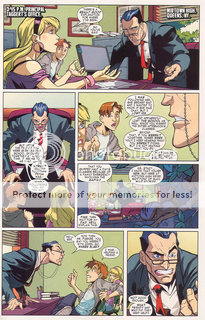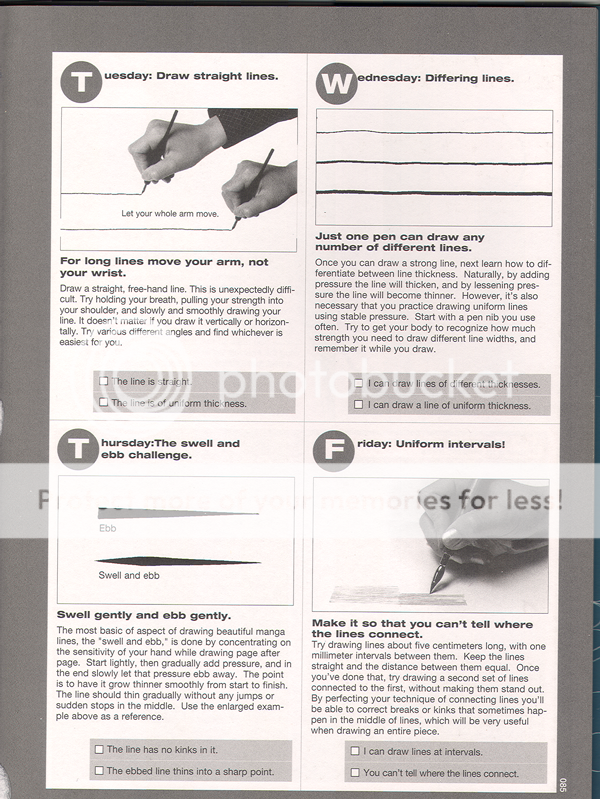Marvel Adventures Spider-man (ISSN: 1548-5056) #55
Tobin, Camagni, and Sotocolor
Geekery question: The title page lists Jacopo Camagni as pencils, but doesn’t list any further artists besides Sotocolor for color. Does anyone know who does the inks? Is it Camagni?
I admit, I’m a little leery of Spider-man comics. Between the truly terrifying Spider-man lip glosses (who would put lipstick from spider-human mutations on their lips? Marvel, get a grip!) and my short but rage inducing brush with Amazing Spider-man’s innards, I was nervous when I got a suggestion last week from Tucker Stone that I should check out a Spider-man comic.
Now, usually I shop for my comics at the Borders, and thus was the case for this week’s haul. I dutifully pawed over the shelves, looking for the correct iteration of Spidy that was recommended. Fantastic? Awesome? Something-something Spider-man…I’d forgotten my list. Ah! I saw a fetching looking number with old skool inks and a limited pallete cover, and thought: Ah-ha! This must be it. I read the first few pages to check. Cute art: check. Funny: check.
I hauled it home and read it on the porch, with the dog at my feet, and laughed and laughed.
It turned out that I’d bought the wrong comic, but that’s OK. I’ll take my list with me next time.
Now, to re-iterate briefly the purpose of my column, since I haven’t been as clear as I should be. I’m a comic-loving manga addict, who has enjoyed some American comics in the past (Sandman), but who has never found and been addicted to a mainstream, superhero comic, despite knowing about and loving both superheroes and comic art of many types. I’m looking for a comic that stars a woman, that’s currently running, and that is awesome. Manga often run into the double digits or more (a volume is roughly a year’s worth collected) and I’ve hopped into the middle of many a manga, so I’m pretty good at catching on to what happens in a regularly told story. Some American comics are, shall we say, designed to require the person reading to collect all four or whatever, and so sometimes lose me. I think this is dirty pool, especially if the comic isn’t honest about it. I’m looking to fall in love, not have a long run of terrifying blind dates whose only redeeming quality is that I can tell my friends about them at our next bar night. /too long explanation of column digression
But back to Spidy.
This comic is hilarious and awesome. I had no idea who anyone was, besides Peter Parker, but I caught on fast, and had a rollicking good time. This comic has some of the best body language art I’ve ever seen. Check out the first page: The principal is so menacing and Peter is such a doofus, the way he’s leaning back but still trying to defend himself, and the girl in the background is so sulky teenager. How is this not awesome?
The principal is so menacing and Peter is such a doofus, the way he’s leaning back but still trying to defend himself, and the girl in the background is so sulky teenager. How is this not awesome?
Plus, the squirrels! Hee!
The comic has a great story format, too. It starts at the end, the time that Peter and Gwen are getting into trouble at school. Then it skips to the beginning of the day and tells us how they got there. It’s not new, but it’s clever and fun.
The start of Peter’s day is shown below. One of the things that I love about this comic is how wonderful the art is for all of the characters. It draws me in and makes me suspend my disbelief. It’s a lot easier to believe that Spidy can climb walls when his world looks so real:
 The chemistry teacher is spot-on. She looks like a chemistry teacher I had once. And they really do pay attention, this artistic team, to the way people look and dress. That awful lime green is really in right now and it’s being paired with purple.
The chemistry teacher is spot-on. She looks like a chemistry teacher I had once. And they really do pay attention, this artistic team, to the way people look and dress. That awful lime green is really in right now and it’s being paired with purple.
Peter’s friend, Chat, isn’t a superhero, but she’s fun and wonderful. She’s the brunette with the terrible taste in salads above.
The plot isn’t all that new: A baddie tries to kidnap Gwen, who is the daughter of a cop, and Spidy has to save her. She’s not completely helpless, though, which I appreciated. She’s the one who suggests climbing the building to get away from the cops who are radioing in their location and also tells Spidy what to do.
 But what I really love about this page? After getting off the building, Gwen pulls down her skirt.
But what I really love about this page? After getting off the building, Gwen pulls down her skirt.
That’s what real girls do. We don’t leave our fannies exposed to the air for random fanboys to gawp at our panties. We pull down our skirts, so we don’t flash anyone and so we’re not cold. I loved this, because it’s so natural and so real. Gwen is a great girl and I really like her. What the realness of the comic allowed me to do is see her as a real person. At one point, when she’s running up some stairs, I thought Hey, cute boots. The chances of me thinking that in most comics I’ve read so far are nil. (Maybe Batwoman, but that would be in a Hey cute fetish boots way, which is not the same.)
Removing the voyeuristic sleaze that I always seem to feel when I read these comics was a great relief. There’s a kind of internal guard that always remains up. When I get together with just women, I relax my guard a bit. Reading this comic was a bit like that. I had some trust that this cool Gwen and this cool Chat wouldn’t suddenly be tied up in weird racy costumes and semi-tortured for the titillation of the reader. No, they’re characters who the writers respect, not objects. I found it relaxing.
The plot goes as plots go: Spidy gets to confront the baddie, with a bit of help, and there’s a cool fight. Then he has to go back to school and face the music. We wind up at the principal’s office at the end, and Spidy is just a kid again, getting in trouble for something the adults don’t understand. It’s fun and funny and great action.
Highly recommended. I will be buying the next issue, and the next after that, and the next after that.













